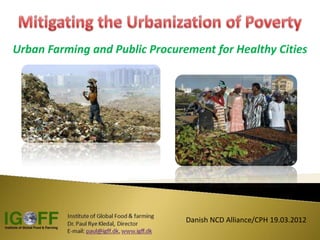Mitigating the urbanization of poverty urban farming & public food procurement for healthy cities
- 1. Urban Farming and Public Procurement for Healthy Cities Danish NCD Alliance/CPH 19.03.2012
- 2. Outline of lecture ŌĆó Urbanization and the changing face of poverty ŌĆó Urban Farming as part of a solution ŌĆó Present overall project idea: Healthy cities ŌĆō Healthy diets: Integrating Urban Farming and Public food procurement
- 3. Urbanization: The mark of the 21 century
- 4. Urban dynamics ŌĆó 60 % of the world is now urban ŌĆō 70% in 35 years ŌĆó Every week a new city emerges with over 1. mio. inhabitants (mostly in developing countries) ŌĆō Growth of Megapolis 10 mio+ ŌĆó Every year the population of France migrates from rural to urban ŌĆó In only 35 years two more India will have emerged (2.5 billion more people)
- 5. Growing Urban Poverty ŌĆó Food crisis & rising food prices ŌĆó The Urban sectorŌĆÖs share of the poor is rising over time ŌĆó Absolute poverty is higher in rural areas (75% of DCŌĆÖs poor still live in rural areas)
- 7. 2 and 3 illustrated Number of poor (millions) Percent of DWŌĆÖs Urban population below each share of poverty line the poor (%) Urban Rural Total Urban Rural Total 1$ a day 1993 236 1,036 1,272 13.5 36.6 27.8 18.5 2002 283 883 1,165 12.8 29.3 22.3 24.2 2$ a day 1993 683 2,215 2,898 39.1 78.2 63.3 23.6 2002 746 2,097 2,843 33.7 69.7 54.4 26.2
- 8. The Slum Dog Billion ŌĆó > 30% of the worldŌĆÖs urban population ŌĆō 1 billion people ŌĆō resides in slums ŌĆó 90% of slum dwellers live in developing world
- 9. Slum population by region
- 10. Urban Agriculture as a solution? ŌĆó 800 mio. people around the world make a living from urban farming ŌĆō major part in the metropolisŌĆÖ of Asia ŌĆó 200 mio. people make a living from selling their urban farm products to a market
- 11. ŌĆó Cities around the world are already producing on average 1/3 of the food the inhabitants consume
- 12. 3 Types of Urban farming ŌĆó Micro scale farm plots integrated with social housing or slum projects (often vacant intra city-plots ŌĆó Smaller scale multifunctional (agro)forestry in green city-corridors or peri-urban areas (often less favorable areas: Steep slopes, river banks, tree belt to stop desertfication, utilizing sewage waste)
- 13. ŌĆó Cluster of more intensive high-tech farming with livestock (pork, chicken and fishfarms) or greenhouse produce inter-acting in different forms of cooperation utilizing manure etc (Often Peri-urban areas)
- 14. Operating within three areas Ecological (Environmental Social (Inclusive city) Healthy city) Subsistence oriented UA Multifunctional UA Production of food for self consumption * Organic and diverse agriculture * Savings on food & health and (agro-) forestry close to expenditures consumers * Some income from selling of ŌĆóCombination with other functions surpluses (recreation, urban greening, * Part of livelihood strategies microclimate, park management, of the urban poor water storage, education) * CO2 reduction Market oriented UA * Income generation from producing food and non-food products for the market * Small scale family based and larger scale entrepreneurial enterprises Economical (Productive city)
- 15. Positive urban farm outcomes ŌĆó Poverty alleviation ŌĆō Reduces food expences (normally 60-80% of household budget) ŌĆō Potential for generating income by surplus sales (30-70$/month compared with minimum wage 20-40$/month) ŌĆō Generating linkages to new jobs in inputs, (organic waste collection, composting), processing and marketing, transport, veterinary services etc
- 16. Positive Urban Farm contŌĆ” ŌĆó Healthy city - Urban food security ŌĆō Buffer on food hikes and food supplies securing potentially a healthy diet ŌĆō Regular food intake ŌĆō Mitigating the ŌĆÖdouble burden of malnutritionŌĆÖ wasting (weight/height) stunting (height/age) diabetes/obesity
- 17. Problems related to Urban farming ŌĆó Health risks for producers as well as consumers (inappropriate use of wastewater, contaminated rivers/streams) ŌĆó Inadequate management of livestock (confinements for collecting urine, manure risk of attracting rats)
- 18. Problems contŌĆ”.. ŌĆó Inadequate supplies of nutrient inputs ŌĆó Theft ŌĆó Exposure to land, air, water contamination from traffic, industry ŌĆó Poor land use security/rights
- 19. Project idea: Healthy Cities ŌĆō Healthy Diets ŌĆó Integrating Urban farming with Public food procurement as a driver for social inclusion (School meal programs, hospitals, nursery) ŌĆō Children are send to school (free meal) ŌĆō Children can stay awake in class ŌĆō Higher chance teachers stay at school ŌĆō Medicine works (aids, TB etc) ŌĆō Educational integration
- 20. Urban Farming targeting: ŌĆó Social inclusion (garden training, nutrient and pest handling, healthy food education) ŌĆó Market sale (marketing training, small shop set up, new service job linkages: organic waste collection, transport, seed or seedling production) ŌĆó Environmental services (sanitary awareness, Greening the city, water management, Demonstration plotsn plots
- 21. Quick conclusions ŌĆó Agriculture & rural development are still important in mitigating poverty ŌĆó But new political initiatives integrating urbanization, poverty and health is needed ŌĆó Urban Farming offers quick and concrete solutions targeting and unifying difficult challenges: ŌĆō Improved food security ŌĆō Better sanitary services and Health ŌĆō Broad range of Environmental services ŌĆō Organic waste collection and compost making ŌĆō New job creation ŌĆō Human & political rights focus




















